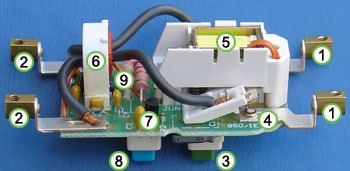File:ResidualCurrentCircuitBreak.jpg
ResidualCurrentCircuitBreak.jpg (350 × 171 pixels, file size: 23 KB, MIME type: image/jpeg)
This file is from Wikimedia Commons and may be used by other projects. The description on its file description page there is shown below.
Summary
| DescriptionResidualCurrentCircuitBreak.jpg |
English: photo of electrical Residual-Current Circuit Breaker
The incoming supply and the neutral conductors are connected to the terminals at (1) and the outgoing load conductors are connected to the terminals at (2). The earth conductor (not shown) is connected through from supply to load uninterrupted. When the reset button (3) is pressed the contacts ((4) and hidden behind (5)) close, allowing current to pass. The solenoid (5) keeps the contacts closed when the reset button is released. The sense coil (6) is a differential current transformer which surrounds (but is not electrically connected to) the live and neutral conductors. In normal operation, all the current down the live conductor returns up the neutral conductor. The currents in the two conductors are therefore equal and opposite and cancel each other out. Any fault to earth (for example caused by a person touching a live component in the attached appliance) causes some of the current to take a different return path which means there is an imbalance (difference) in the current in the two conductors (single phase case), or, more generally, a nonzero sum of currents from among various conductors (for example, three phase conductors and one neutral conductor). This difference causes a current in the sense coil (6) which is picked up by the sense circuitry (7). The sense circuitry then removes power from the solenoid (5) and the contacts (4) are forced apart by a spring, cutting off the electricity supply to the appliance. The device is designed so that the current is interrupted in a fraction of a second, greatly reducing the chances of a dangerous electric shock being received. The test button (8) allows the correct operation of the device to be verified by passing a small current through the orange test wire (9). This simulates a fault by creating an imbalance in the sense coil. If the RCD does not trip when this button is pressed then the device must be replaced. |
| Date | |
| Source | Own work |
| Author | Ali@gwc.org.uk |

|
Permission is granted to copy, distribute and/or modify this document under the terms of the GNU Free Documentation Licence, Version 1.2 or any later version published by the Free Software Foundation; with no Invariant Sections, no Front-Cover Texts, and no Back-Cover Texts. A copy of the licence is included in the section entitled GNU Free Documentation Licence.http://www.gnu.org/copyleft/fdl.htmlGFDLGNU Free Documentation Licensetruetrue |
| This file is licensed under the Creative Commons Attribution-Share Alike 3.0 Unported licence. | ||
| ||
| This licencing tag was added to this file as part of the GFDL licencing update.http://creativecommons.org/licenses/by-sa/3.0/CC BY-SA 3.0Creative Commons Attribution-Share Alike 3.0truetrue |
Captions
Items portrayed in this file
depicts
some value
17 July 2004
File history
Click on a date/time to view the file as it appeared at that time.
| Date/Time | Thumbnail | Dimensions | User | Comment | |
|---|---|---|---|---|---|
| current | 01:19, 6 August 2005 |  | 350 × 171 (23 KB) | wikimediacommons>Glenn | Information from the en-wiki: "... photo of electrical Residual-Current Circuit Breaker this photo was taken, annotated and uploaded by me (--Ali@gwc.org.uk 13:50, 17 Jul 2004 (UTC)) This image is hereby licensed under the terms |
File usage
The following page uses this file:
Metadata
This file contains additional information, probably added from the digital camera or scanner used to create or digitise it.
If the file has been modified from its original state, some details may not fully reflect the modified file.
| _error | 0 |
|---|
